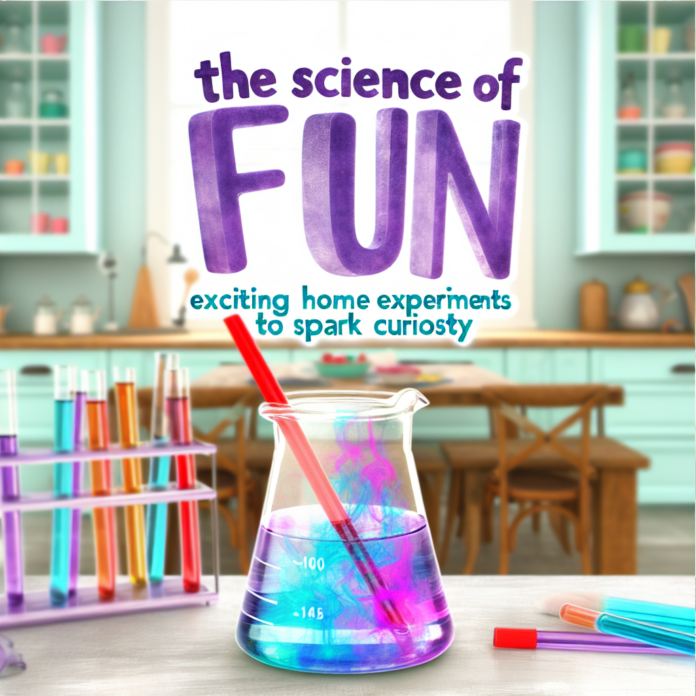The Science of Fun: Exciting Home Experiments to Spark Curiosity
Ever found yourself aimlessly scrolling through your smartphone, wishing you could transform that idle moment into something meaningful? You’re not alone. In a world where technology dominates, many of us find ourselves yearning for a deeper connection—whether it’s through learning, exploring, or simply having fun. What if you could blend entertainment with education right in your living room? That’s where the science of fun comes in.
In this article, we’re diving into a collection of engaging home experiments that not only amuse but also spark curiosity in the wonderfully intricate world of science. Let’s spark your inner scientist and have some fun while doing it!
Experiment 1: The Color-Changing Milk
Do you remember being mesmerized by colorful rainbows as a child? You can create your own vibrant display with nothing more than milk, food coloring, and dish soap. This experiment is not only visually stunning but also a fantastic way to introduce concepts like chemical reactions and surface tension.
What You’ll Need:
- 1 shallow plate
- Milk (whole or 2% work best)
- Food coloring (multiple colors)
- Dish soap
- Toothpick or cotton swab
Instructions:
- Pour milk into the shallow plate until it covers the bottom.
- Drop different colors of food coloring around the milk.
- Dip the toothpick or cotton swab into dish soap, then gently touch the surface of the milk.
- Watch the colors explode into beautiful patterns as the soap interacts with the milk!
As the soap touches the milk, it breaks the surface tension, causing the food coloring to swirl and dance beautifully. Feel free to get creative with different color combos, and remember, sometimes a bit of chaos creates the most beautiful results!
Experiment 2: Homemade Volcano Eruption
If you’ve ever dreamed of unleashing a bit of chaos in your kitchen, this classic experiment is the perfect fit. The homemade volcano eruption allows you to explore chemical reactions by creating a mini-explosion that’s both safe and spectacular.
What You’ll Need:
- 1 cup baking soda
- 1 cup vinegar
- Food coloring (optional)
- A container (like a plastic bottle)
- Tray or large dish to catch the mess
Instructions:
- Put your container on a tray or in a large dish to catch the overflow.
- Add the baking soda into the container.
- If you want to make it colorful, add a few drops of food coloring.
- Pour the vinegar into the container and step back!
As the vinegar meets the baking soda, a chemical reaction occurs that produces carbon dioxide gas, resulting in a fizzy, overflowing, brightly colored “lava” that spills over the edges. The best part? You can continue the experiment multiple times—just adjust the amounts and colors for even wilder eruptions!
Experiment 3: Balloon-Powered Car
Mix engineering and physics with a fun hands-on project: creating a balloon-powered car! This activity not only entertains but also teaches a little bit about forces, motion, and mechanics.
What You’ll Need:
- Balloon
- Straw
- Two plastic bottle caps (wheels)
- Skewers or sticks (axles)
- Cardboard or a firm base for the car body (optional)
Instructions:
- Attach the bottle caps to the ends of the skewers to act as wheels.
- Insert the skewers through the base of your cardboard or firm base.
- Take a straw and cut it to a desirable length. Attach it to the balloon, making sure the balloon can be inflated.
- Secure the straw vertically to the base so that it points backward.
- Blow up the balloon, pinch it to keep the air inside, then place your car on a flat surface and release!
As the balloon releases air, it propels the car forward thanks to Newton’s Third Law: for every action, there is an equal and opposite reaction. Challenge your friends and family to see whose car goes the farthest, and get creative with designs!
Experiment 4: The Classic Egg in a Bottle
This experiment is a brilliant way to demonstrate air pressure in a way that’s surprisingly easy yet profoundly mind-blowing. You might even discover how just a simple egg can cause a stir in your household!
What You’ll Need:
- Hard-boiled egg, peeled
- A glass bottle with a neck slightly smaller than the egg (like a soda bottle)
- Strip of paper
- Matches or lighter (with adult supervision)
Instructions:
- Light the strip of paper and carefully drop it into the bottle.
- Quickly place the egg on the opening of the bottle.
- Watch as the egg gets sucked into the bottle!
The lighted paper heats the air inside the bottle, causing it to expand. When the flame goes out, the cooler air inside creates lower pressure than the outside air, pulling the egg in. It’s a neat trick and an eye-opening lesson on the power of atmospheric pressure!
Let Curiosity Be Your Guide
By diving into these simple yet fascinating experiments, you’re setting the stage for a lifelong love of science and exploration. The world is full of inspiring mysteries, waiting for curious minds to unravel them. Whether you’re engaging alone or with family, these experiments provide an exciting gateway into the world of learning and discovery.
Next time you feel the urge to scroll mindlessly on your phone, why not swap it for engaging in a fun experiment? You’ll not only find entertainment but also ignite your curiosity and sense of wonder, building connections to the scientific principles that make the world around us so intriguing. Let the science of fun transform how you see your living room—into a laboratory of discovery!
So, gather your supplies, invite some friends over, and let the curiosity flow. Experimentation isn’t just for classrooms; it’s for anyone ready to explore! Who knows what you might discover…

